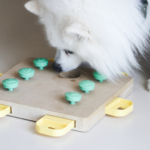Introduction
In an era dominated by technology, pet owners have witnessed a surge in innovative gadgets and apps designed to enhance the lives of their furry companions. From health monitoring to interactive play, the pet tech industry is booming. This article aims to guide modern dog owners through the labyrinth of pet technology, offering insights into trends, benefits, and practical solutions for a seamless integration of these advancements into daily life.
Health and Wellness Tech
In the rapidly evolving landscape of pet technology, health-monitoring devices and apps have emerged as revolutionary tools for proactive pet care. These innovations allow pet owners to stay ahead of potential health issues, ensuring the well-being of their furry companions.
One of the primary benefits of health-monitoring devices is their ability to provide real-time insights into a pet’s vital signs, activity levels, and overall health metrics. This proactive monitoring enables early detection of anomalies, allowing pet owners to take timely action and consult with veterinarians when necessary. From smart collars to wearable health trackers, these devices offer a comprehensive view of a pet’s health beyond what meets the eye.
However, amid the excitement of these advancements, pet owners must navigate challenges related to data accuracy. Ensuring that the information gathered is precise and reliable is essential for making informed decisions about a pet’s health. Issues such as sensor inaccuracies or device malfunctions can pose concerns.
To address these challenges, pet owners should prioritize research and choose health-monitoring devices from reputable manufacturers. Reading user reviews, seeking recommendations from veterinarians, and considering the device’s track record for accuracy are crucial steps in making informed decisions. Additionally, maintaining regular check-ups with a veterinarian remains a cornerstone of proactive pet care, with health-monitoring tech serving as a complementary tool rather than a replacement.
Connected Playtime
Interactive toys and playtime gadgets have transformed the landscape of canine entertainment, providing dogs with mental stimulation and physical activity. Play is a fundamental aspect of a dog’s life, contributing significantly to their physical and mental health. Interactive toys engage a dog’s natural instincts, promoting mental stimulation, problem-solving skills, and physical exercise. These gadgets range from treat-dispensing puzzle toys to electronic interactive devices designed to keep dogs entertained and active.
However, as technology infiltrates the world of dog play, challenges related to durability and safety arise. Dogs, especially those with strong jaws and a penchant for chewing, can quickly render some toys useless or even pose a choking hazard. Additionally, electronic components in certain gadgets may not withstand the rough play of exuberant dogs, leading to malfunctions or safety concerns.
To navigate these challenges, pet owners should prioritize durable playtech options specifically designed for robust canine play. Look for toys made from high-quality materials that can withstand chewing and tossing. Consider the size and construction of the toy to minimize the risk of choking hazards. Reading product reviews and seeking recommendations from veterinarians or fellow pet owners can provide valuable insights into the durability and safety of specific interactive toys.
When selecting playtech for your canine companion, opt for products that align with your dog’s size, play style, and preferences. Introduce new gadgets gradually, ensuring they enhance, rather than replace, traditional play and bonding time with your dog. By selecting engaging and safe interactive toys, pet owners can provide their furry friends with enriching play experiences that contribute to a happy, healthy, and stimulated life.
Training and Behavior Apps
As technology continues to advance, dog owners are increasingly turning to training and behavior modification apps to aid in shaping their canine companions’ behavior. Training and behavior modification apps have gained popularity for their convenience and accessibility. They offer a range of features, from basic commands to addressing specific behavioral issues, providing a virtual toolkit for dog owners. These apps often include step-by-step guides, video demonstrations, and progress tracking, allowing users to tailor training programs to their dog’s individual needs.
Despite their advantages, challenges exist in the reliability of these apps. The effectiveness of training apps depends on various factors, such as the dog’s temperament, the owner’s consistency, and the specific nature of the behavior being addressed. While some dogs may respond well to virtual guidance, others may require hands-on training from a professional.
To maximize the benefits of training and behavior modification apps, dog owners should approach them as supplements rather than substitutes for traditional training methods. Consistency is key, and incorporating positive reinforcement techniques is crucial for success. It’s essential to set realistic expectations, understanding that each dog is unique and may respond differently to virtual training methods.
Additionally, seeking guidance from professional trainers or behaviorists can complement the use of apps, providing personalized insights and addressing specific challenges. When integrating apps into a comprehensive training strategy, dog owners should use them as tools within a broader framework of positive reinforcement, consistency, and patience.
Safety and Location Tracking
In the evolving landscape of pet care technology, GPS trackers and smart collars have emerged as invaluable tools for enhancing pet safety and providing peace of mind to conscientious pet owners.
GPS trackers and smart collars are designed to offer real-time location tracking for pets, allowing owners to monitor their whereabouts and receive alerts if they stray beyond predefined boundaries. While these devices contribute significantly to pet safety, concerns about their weight, comfort, and privacy implications have been raised.
One of the primary concerns is the weight of the device and its impact on the pet’s comfort. It’s crucial to select a GPS tracker or smart collar that is appropriately sized for your pet’s breed and weight. Many modern devices are designed to be lightweight and compact, ensuring that they don’t cause discomfort or hinder your pet’s movements.
Comfort is not only about the weight but also about the materials used in the device. Opt for trackers with soft, hypoallergenic materials to prevent irritation or chafing. Ensuring that the collar is adjustable and fits securely without being too tight is essential for your pet’s comfort.
Privacy concerns regarding the data collected by these devices also need consideration. Choose GPS trackers and smart collars from reputable manufacturers who prioritize data security. Read user reviews and privacy policies to understand how the collected information is handled and stored.
When selecting a GPS tracker or smart collar, consider the specific needs of your pet and your preferences. Look for features such as real-time tracking, geofencing capabilities, and long battery life. Additionally, explore whether the device integrates with user-friendly mobile apps for seamless monitoring.
Mealtime Management
As technology continues to advance, smart feeding solutions have become increasingly popular in the realm of pet care. These innovative gadgets aim to simplify the feeding process and enhance pet nutrition.
Smart feeding solutions encompass a range of devices, from automated feeders with portion control features to smartphone-connected dispensers. These gadgets offer pet owners the convenience of managing feeding schedules, monitoring portions, and even dispensing meals remotely.
One of the primary concerns associated with smart feeding solutions is the potential overreliance on technology. Pet owners may worry that these devices could replace essential aspects of hands-on care and diminish the quality of the human-animal bond. It’s essential to recognize that while these gadgets can streamline feeding processes, they should complement, not replace, the attention and care provided by pet owners.
Another concern is the possibility of malfunctions or technical glitches. To address this, choose smart feeding solutions from reputable manufacturers with positive user reviews. Regularly clean and maintain the devices according to the manufacturer’s guidelines to minimize the risk of malfunctions. Additionally, it’s advisable to monitor your pet’s behavior and weight to ensure that the automated feeding system is functioning correctly.
To integrate smart feeding solutions into a balanced feeding routine, establish a schedule that includes regular, interactive feeding times with your pet. Use these moments to reinforce the bond between you and your furry companion. Consider incorporating a variety of feeding methods, such as puzzle toys or hand-feeding, to engage your pet mentally and physically.
Conclusion
As technology continues to shape the pet care landscape, staying informed about the latest trends and understanding potential challenges is crucial. With the right knowledge, dog owners can embrace the benefits of pet tech, enhancing their furry friends’ lives while navigating the digital landscape responsibly.









